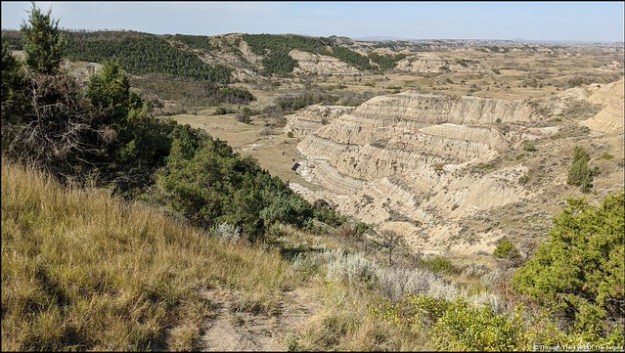While in Bismarck we visited nearby Fort Abraham Lincoln State Park. Fort Abraham Lincoln was an infantry and cavalry post from which Lt Col George Custer led the 7th Cavalry to the Battle of the Little Bighorn in 1876. The fort provided protection for the railroad workers and survey crews from Indian attack. It also provided protection to settlements being established in the area.
Due to increased attacks by the Sioux, Congress authorized a cavalry post to the fort. Lt Col George Custer arrived in 1873 with six companies of the 7th Calvary.
The fort was abandoned in 1891 and local residents disassembled the fort for its nails and wood. It is said that many old homes in the Bismarck area have lumber and pieces of the old fort in them. In 1907 President Theodore Roosevelt signed the land over to the state of North Dakota for a state park. 
From 1934-38 the Civilian Conservation Corps (CCC) built a visitors center, roads, reconstructed blockhouses and placed cornerstones where fort buildings once stood. All 250 members of this CCC were Great War (World War I) veterans
Also in the park the CCC replicated Mandan earthen lodges to recreate a Mandan village called “On-a-Slant Village”. 

The original Mandan Village was established in the late 16th century and was inhabited until 1781. It consisted of approximately 86 earthen lodges with a population of between 1,000-1,500 and was located where the Heart and Missouri Rivers come together. 






In 1781 a smallpox epidemic killed over three out of every four villagers. After the epidemic the Mandan moved north.
The Lewis and Clark Expedition spent the winter of 1804-05 with friendly Mandan. They stayed again in 1806 on their return trip. The Sioux eventually drove the Mandan from the area. 
A reproduction of Custer’s house was built in 1989 in time for the state’s centennial celebration. Custer and his wife Libbie lived at Fort Abraham Lincoln from 1873 until Custer died at the Battle of the Little Bighorn in 1876. 


We walked to one of three reconstructed blockhouses once used to defend the fort. I waited down below while Bill climbed a staircase followed by a steep ladder to the observation post. It was a beautiful day with great views including the capitol building in the distance, the only tall building in Bismarck. 




Inside the blockhouse was a nest of baby swallows. We saw the mama bird flying in and out of the building. 
While in the park we traveled down to the river where the Heart and Missouri Rivers converge. 
Next we drove to Keelboat Park along the Missouri River with a 55 foot full scale replica similar to the keelboat used by Lewis and Clark. The Expedition’s keelboat carried a number of plants and animals collected on their journey including live magpies, a prairie dog, a prairie grouse hen, 108 botanical specimens, 68 mineral samples, pronghorn skeletons, insects, mice, and various animal hides. It also included a 45,000 word report to President Thomas Jefferson with descriptions of teepee, Indian myths and customs and other ethnological observations and maps. 

Also in the park were unusual metal sculptures of Lewis, Clark and Sacajawea painted the colors of traffic lights. 
Another sculptures is called “Thunderbirds”. To the Native Americans the thunderbirds are part of the Great Spirit who lives among us in the clouds. The thunderbirds bring lightning flashes from their eyes and produce thunder by the flapping of their wings. 
We enjoyed our stay in Bismarck.
Next up: South Dakota!




















































































































